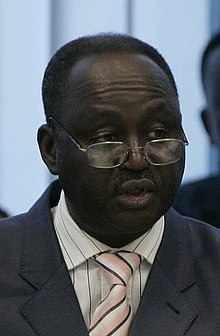Portal:Central African Republic
The Central African Republic Portal
The Central African Republic (CAR), formerly known as Ubangi-Shari, is a landlocked country in Central Africa. It is bordered by Chad to the north, Sudan to the northeast, South Sudan to the east, the Democratic Republic of the Congo to the south, the Republic of the Congo to the southwest, and Cameroon to the west. Bangui is the country's capital and largest city, bordering the Democratic Republic of the Congo. The Central African Republic covers a land area of about 620,000 square kilometres (240,000 sq mi). As of 2024, it has a population of 5,357,744, and is in the scene of a civil war, which has been ongoing since 2012. As a former French colony, French is the official language, with Sango, a Ngbandi-based creole language as the national and co-official language. The Central African Republic mainly consists of Sudano-Guinean savannas, but the country also includes a Sahelo-Sudanian zone in the north and an equatorial forest zone in the south. Two-thirds of the country is within the Ubangi River basin (which flows into the Congo), while the remaining third lies in the basin of the Chari, which flows into Lake Chad. What is today the Central African Republic has been inhabited since at least 8,000 BCE. The country's borders were established by France, which began annexing portions to the French Congo in the late 19th century and in 1903 established the separate colony of Ubangi-Shari, part of French Equatorial Africa. After gaining independence from France in 1960, the Central African Republic was ruled by a series of autocratic leaders, including under Jean-Bedel Bokassa who changed the country's name to the Central African Empire and ruled as a monarch from 1976 to 1979. By the 1990s, calls for democracy led to the first multi-party democratic elections in 1993. Ange-Félix Patassé became president, but was later removed by General François Bozizé in a 2003 coup. The Central African Republic Bush War began in 2004 and, despite a peace treaty in 2007 and another in 2011, civil war resumed in 2012. The civil war perpetuated the country's poor human rights record: it was characterized by widespread and increasing abuses by various participating armed groups, such as arbitrary imprisonment, torture, and restrictions on freedom of the press and freedom of movement. (Full article...) Selected article -François Bozizé Yangouvonda (born 14 October 1946) is a Central African politician who was President of the Central African Republic from 2003 to 2013. He was the only Central African president born in modern-day Gabon. Bozizé rose to become a high-ranking army officer in the 1970s, under the rule of Jean-Bédel Bokassa. After Bokassa was ousted, Bozizé served in the government as Minister of Defense from 1979 to 1981 and as Minister of Information from 1981 to 1982. He participated in a failed 1982 coup attempt against President André Kolingba and subsequently fled the country. Years later, he served as Army Chief of Staff under President Ange-Félix Patassé, but began a rebellion against Patassé in 2001. (Full article...) General images -The following are images from various Central African Republic-related articles on Wikipedia.
MapDid you know (auto-generated)
Entries here consist of Featured articles and Good articles, which consist of high-quality content on English Wikipedia..
Bangui (French pronunciation: [bɑ̃ɡi]; or Bangui in Sango, formerly written Bangui in English) is the capital and largest city of the Central African Republic. It was established as a French outpost in 1889 and named after its location on the northern bank of the Ubangi River (French: Oubangui); the Ubangi itself was named from the Bobangi word for the "rapids" located beside the settlement, which marked the end of navigable water north from Brazzaville. The majority of the population of the Central African Republic lives in the western parts of the country, in Bangui and the surrounding area. The city has been part of Bangui Prefecture since December 2020. As of 2020[update] it had an estimated population of 889,231. (Full article...) CategoriesWikiProjectsRelated portalsCities
* not the capital of the prefecture
TopicsAssociated WikimediaThe following Wikimedia Foundation sister projects provide more on this subject:
Discover Wikipedia using portals | ||||||||||||||||||||||||||||||||||||||||||||||||||||||||||||||||






























































